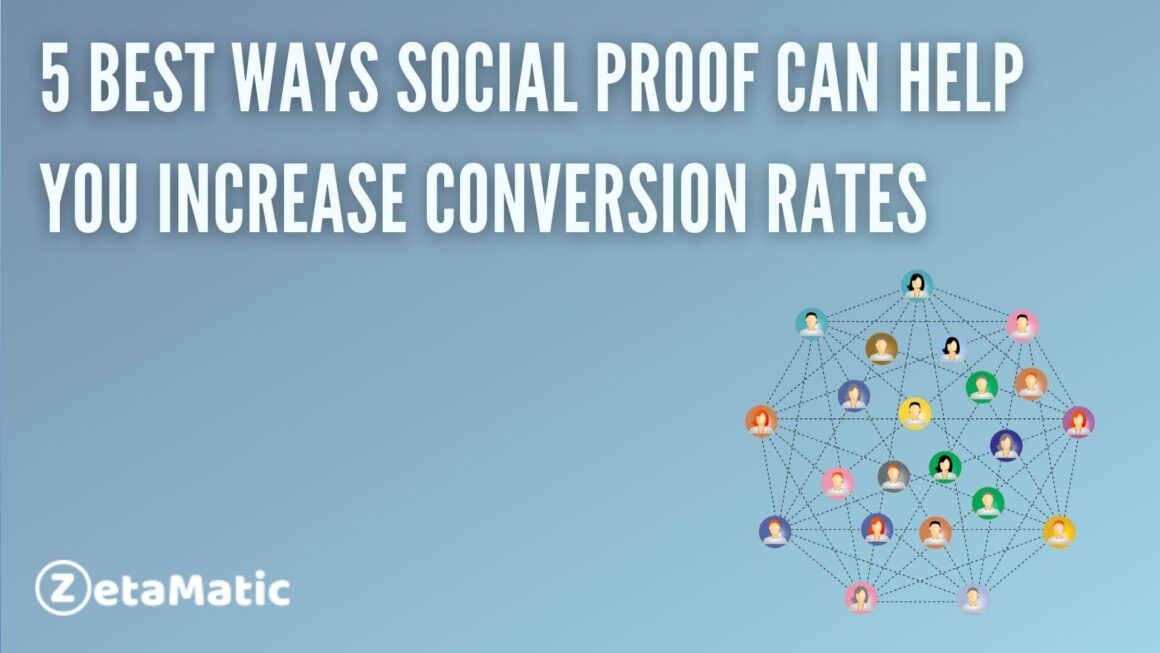As an e-commerce company, one of the most important metrics to track is conversion rate. In fact, the average conversion rate for shopping carts on e-commerce websites is around 2-3%, which means that 98-97% of your visitors will leave your site without becoming customers. This may appear impossible to overcome, but there are numerous methods for increasing your conversion rate and increasing your online sales.
Here are five easy and effective ways to use social proof to boost your website’s conversion rate. But, before we get into the list, if you’re a beginner and don’t know what social proof is, let’s first define it.
What is Social Proof?
When people perceive that other people are acting in a certain way, they are more likely to behave in the same way. It works especially well when combined with testimonials, ratings, and reviews. To understand why social proof boosts conversion rates, you must first understand how it works at the individual level. When we use services such as Amazon, we rely on social proof to make purchasing decisions.
You might be wondering what a rating or review has to do with purchasing behavior, but it turns out that humans are naturally lazy creatures. We don’t want to put in the effort if we don’t have to. If I were looking for zombie books, I’d rather look at 3-star rated books than 5-star rated books – unless all of my friends said 5-star rated books were awesome. People purchase products based on their own desires, not necessarily on what you would expect them to purchase.
Why is Social Proof Effective?
Humans are hardwired to desire what others have. Consider this. How many times have you purchased something because you didn’t want to be left out of having something that everyone else seemed to have? You buy it because you don’t want other people to think you can’t afford it or don’t know what cool is.
This is true not only socially, but also professionally, particularly when selecting a platform. Customers are naturally drawn to social proof, which helps build trust in your brand and increases the likelihood of a conversion. Click-through rates and conversions will increase if you use these methods for incorporating social proof into your website design!
Now, let’s look at the ways social proof can help boost conversion rates.
5 ways Social Proof can help increase Conversion Rates
1. Product Images

Make sure that every product on your e-commerce site has an image, even if it seems obvious. Also, make sure there is a lot of variation in the appearance of these images. If you’re selling ten different types of bicycle helmets, display them all! Show people riding bikes, helmets in use, close-ups of various colors—each one should have its own image.
This shows customers that you’re serious about what you sell and gives them visual assurance that they’re getting a good deal. Images are important, especially if you run an e-commerce site.
The truth is that 90% of information transmitted to our brains is visual. As a result, we rely heavily on visuals to comprehend information… including potential purchases. With so much riding on the appearance of a website, it’s no surprise that social proof plays such a large role in online purchasing decisions.
2. Testimonials

Testimonials are an excellent way to establish your authority on a particular subject or niche. It can do wonders for conversions as long as they are from real clients who are saying nice things about you or your business.
However, there are several types of testimonials. One of them is from a customer who saw immediate results from using your product or service.
Then there’s what’s known as third-party proof, which is when a reliable source says nice things about you and/or something that happened in connection with you or something you did.
3. Case Studies

There is no better way to demonstrate that something works than to show real people using it. Include two or three case studies of businesses similar to yours that saw a boost in conversion rates after implementing social proof on their website.
Interview each business and ask them questions such as:
- Why did you decide to include social proof on your website?
- What type of social proof do you use?
- How has including social proof helped convert visitors into customers?
Case studies can offer a more personal perspective and serve as excellent examples for others seeking inspiration.
4. Reviews

Not all social proof is created equal when it comes to generating conversions. Some forms of social proof are even ineffective! That is why it is critical to distinguish between those who will convert and those who will not. To put it simply, you want as many positive, non-spammy reviews as possible.
In other words, no one wants a slew of phony testimonials or comments from people who have never used your product before—only genuine satisfied customers will help you sell more products.
Take a look at these figures: According to 33% of consumers, they read online reviews in depth. When researching purchases, 68 percent consult multiple sources. In their decision-making process, 90 percent of consumers trust consumer opinions posted online by others.
Almost every company, understandably, tries to generate review traffic, but there are two common mistakes that are frequently made when using them for marketing purposes.
- The first blunder is soliciting reviews without providing anything in return. This method usually yields exactly what you’d expect: very few reviews (if any).
- The second error is to overpromise on what will be delivered in exchange for reviews. You can ask someone to share their honest opinions about your product or service, but make sure it’s an honest exchange.
Once again, low-quality reviews are largely ineffective…and should generally be deleted. Your reputation is riding on your ability to keep your word!
5. Share Counts

While vanity metrics are easy to become engrossed in, you should also pay attention to other, more qualitative metrics that will help guide your growth. One of these is social proof, or how many people are sharing and discussing your brand online. People will not share you on social media if you are not doing something right or truly stand out in some way. However, if they are discussing and sharing their experiences with you, it could be because you are doing something worthwhile (and profitable).
By tracking shares and likes for specific content, you can learn what customers like about what you’re offering (and which parts of your offering they don’t like). Then, from any page on your website, add a Share Bar so users can easily share your content with their friends.
Conclusion
Social proof has been used for years, and it has proven its worth time and time again. If you want to boost conversions on your website, social proof is a good place to start. It can help build trust and credibility among consumers, improving their perception of you and increasing conversions over time. By building trust and authority among prospective customers, you’ll find that new leads will come pouring in. So, what are you waiting for? Start implementing it on your site today!
Feel free to give us any suggestions or comments. For updates, guides, listicles, and more, like our Facebook page, follow us on Twitter, and subscribe to our YouTube channel.
You may also like:









